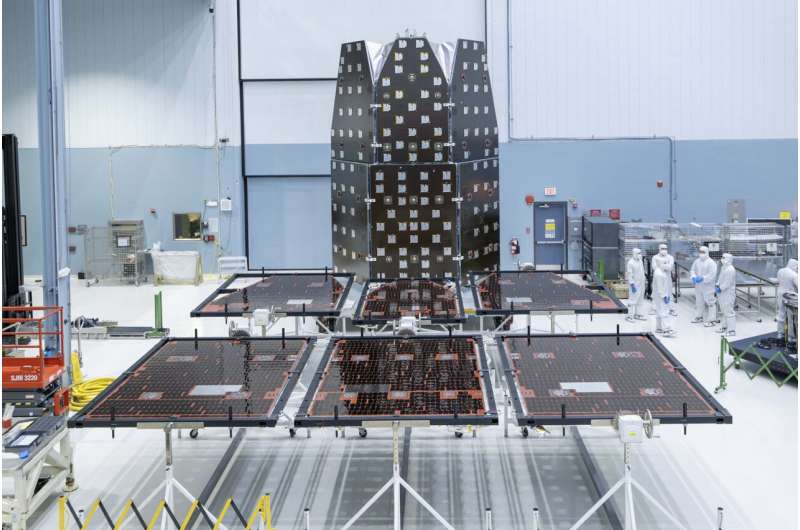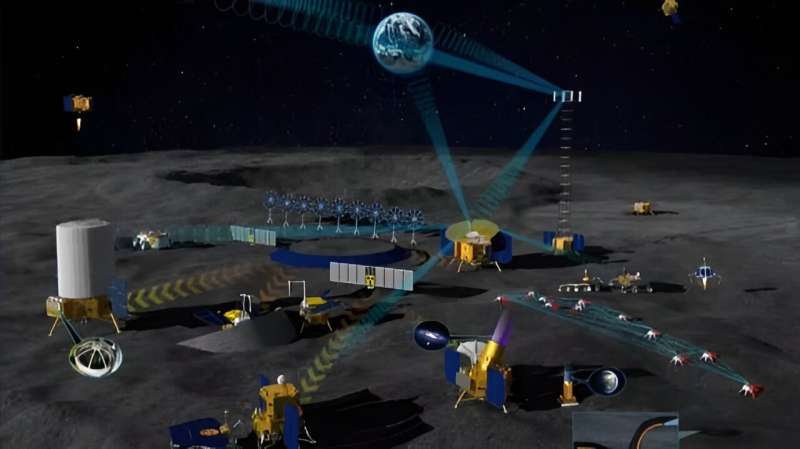
Copernical Team
Liquid Intelligent to expand 5G services across Africa and the Middle East
 Liquid Intelligent Technologies (Liquid), a subsidiary of Cassava Technologies, has announced a strategic partnership with Globalstar, a U.S.-based leader in connectivity, to roll out advanced 5G solutions across Africa, the Middle East, and the Gulf regions.
Strive Masiyiwa, founder and Chairman of Liquid Intelligent Technologies, expressed enthusiasm about the potential of this collabora
Liquid Intelligent Technologies (Liquid), a subsidiary of Cassava Technologies, has announced a strategic partnership with Globalstar, a U.S.-based leader in connectivity, to roll out advanced 5G solutions across Africa, the Middle East, and the Gulf regions.
Strive Masiyiwa, founder and Chairman of Liquid Intelligent Technologies, expressed enthusiasm about the potential of this collabora NASA's EXCITE mission prepared for scientific balloon flight
 Scientists and engineers are ready to fly an infrared mission called EXCITE (EXoplanet Climate Infrared TElescope) to the edge of space.
EXCITE is designed to study atmospheres around exoplanets, or worlds beyond our solar system, during circumpolar long-duration scientific balloon flights. But first, it must complete a test flight during NASA's fall 2024 scientific ballooning campaign fr
Scientists and engineers are ready to fly an infrared mission called EXCITE (EXoplanet Climate Infrared TElescope) to the edge of space.
EXCITE is designed to study atmospheres around exoplanets, or worlds beyond our solar system, during circumpolar long-duration scientific balloon flights. But first, it must complete a test flight during NASA's fall 2024 scientific ballooning campaign fr Salsa Satellite's reentry to be observed live from the sky
 On September 8, 2024, the first of the four Cluster satellites, known as Salsa, will reenter Earth's atmosphere in an uncontrolled "targeted reentry" over a remote area in the South Pacific Ocean. This event marks a significant moment in reentry observation as scientists seek to gather valuable data on satellite disintegration.
In the nearly seven decades of space exploration, approximatel
On September 8, 2024, the first of the four Cluster satellites, known as Salsa, will reenter Earth's atmosphere in an uncontrolled "targeted reentry" over a remote area in the South Pacific Ocean. This event marks a significant moment in reentry observation as scientists seek to gather valuable data on satellite disintegration.
In the nearly seven decades of space exploration, approximatel SETI launches low-frequency search for extraterrestrial technology in distant galaxies
 The SETI Institute, in collaboration with the Berkeley SETI Research Center and the International Centre for Radio Astronomy Research, has initiated a pioneering study using the Murchison Widefield Array (MWA) in Western Australia. Led by Dr. Chenoa Tremblay of the SETI Institute and Prof. Steven Tingay of Curtin University, this research marks the first search for alien technology in galaxies b
The SETI Institute, in collaboration with the Berkeley SETI Research Center and the International Centre for Radio Astronomy Research, has initiated a pioneering study using the Murchison Widefield Array (MWA) in Western Australia. Led by Dr. Chenoa Tremblay of the SETI Institute and Prof. Steven Tingay of Curtin University, this research marks the first search for alien technology in galaxies b LEO satellites enhance GPS accuracy through ground station integration
 Ensuring precise Global Navigation Satellite System (GNSS) orbit and clock data is vital for various critical applications. A new method that integrates data from regional ground stations with measurements from Low Earth Orbit (LEO) satellites has been shown to significantly improve the accuracy of GNSS orbits, advancing precision from meters to centimeters. This development is particularly bene
Ensuring precise Global Navigation Satellite System (GNSS) orbit and clock data is vital for various critical applications. A new method that integrates data from regional ground stations with measurements from Low Earth Orbit (LEO) satellites has been shown to significantly improve the accuracy of GNSS orbits, advancing precision from meters to centimeters. This development is particularly bene Cluster concludes with controlled reentry over South Pacific
 On September 8, 2024, the first of four satellites from ESA's long-running Cluster mission will reenter Earth's atmosphere, descending over the South Pacific Ocean's Uninhabited Area. This event marks the conclusion of the 24-year mission, which has significantly advanced our understanding of Earth's magnetic environment. Although the remaining three satellites will no longer conduct scientific
On September 8, 2024, the first of four satellites from ESA's long-running Cluster mission will reenter Earth's atmosphere, descending over the South Pacific Ocean's Uninhabited Area. This event marks the conclusion of the 24-year mission, which has significantly advanced our understanding of Earth's magnetic environment. Although the remaining three satellites will no longer conduct scientific NASA advances solar sail deployment efforts after initial delay
 NASA's Advanced Composite Solar Sail System (ACS3) has initiated deployment operations for its innovative solar sail. However, during the initial attempt to unfurl the sail, the process was paused when an onboard power monitor detected higher-than-expected motor currents. Despite this, communications, power, and attitude control for the spacecraft all remain normal. Mission managers are now focu
NASA's Advanced Composite Solar Sail System (ACS3) has initiated deployment operations for its innovative solar sail. However, during the initial attempt to unfurl the sail, the process was paused when an onboard power monitor detected higher-than-expected motor currents. Despite this, communications, power, and attitude control for the spacecraft all remain normal. Mission managers are now focu SpaceX Polaris Dawn launch pushed back after helium leak
 SpaceX on Monday pushed back the historic launch of an all-civilian crew on an orbital expedition set to mark a new chapter in space exploration with the first spacewalk by private citizens.
The Polaris Dawn mission, organized by billionaire entrepreneur Jared Isaacman, was set to lift off early Tuesday from NASA's Kennedy Space Center, but is now targeting early Wednesday after a late techn
SpaceX on Monday pushed back the historic launch of an all-civilian crew on an orbital expedition set to mark a new chapter in space exploration with the first spacewalk by private citizens.
The Polaris Dawn mission, organized by billionaire entrepreneur Jared Isaacman, was set to lift off early Tuesday from NASA's Kennedy Space Center, but is now targeting early Wednesday after a late techn Solar panels for NASA's Roman Space Telescope pass key tests

China proposes magnetic launch system for sending resources back to Earth

In his famous novel "The Moon is a Harsh Mistress," Robert A. Heinlein describes a future lunar settlement where future lunar residents ("Loonies") send payloads of wheat and water ice to Earth using an electromagnetic catapult.
In the story, a group of Loonies conspire to take control of this catapult and threaten to "throw rocks at Earth" unless they recognize Luna as an independent world. Interestingly enough, scientists have explored this concept for decades as a means of transferring lunar resources to Earth someday.
Given that space agencies are planning on sending missions to the moon to create permanent infrastructure, there is renewed interest in this concept. In a recent paper, a team of scientists from China's Shanghai Institute of Satellite Engineering (SAST) detailed how a magnetic launcher on the lunar surface could provide a cost-effective means of sending resources back to Earth.

